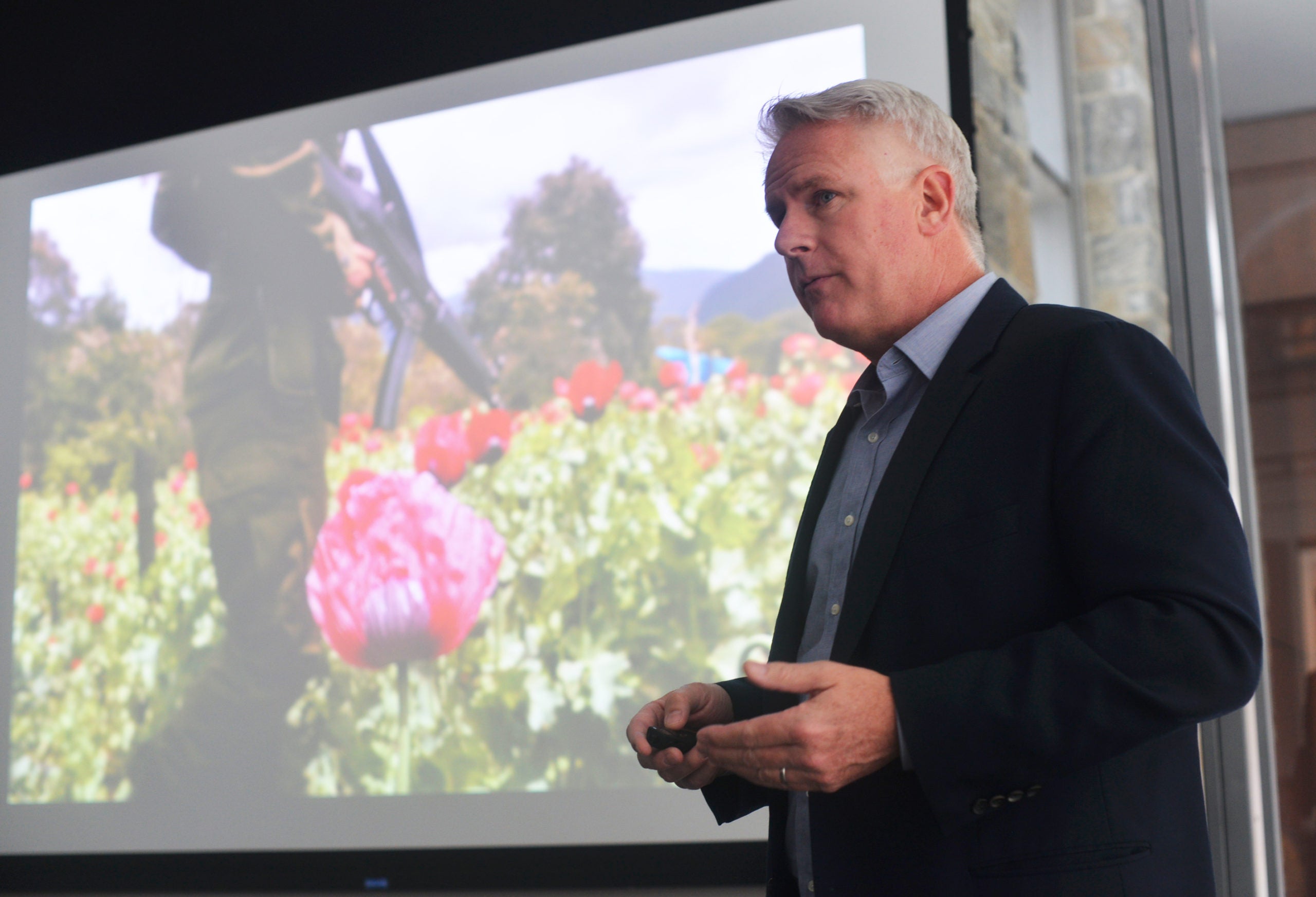Pulitzer Prize-Winning Photographer Shares Work Featuring Immigrants from Border and Australian Wildfires
Photographer John Moore, winner of the Pulitzer Prize and the World Press Photo of the Year, visited campus Monday to show images from his recent work on immigration at the U.S. – Mexico border and the victims of the recent Australian wildfires. His body of work focuses primarily on humanizing issues that tend to emphasize statistics.
Documenting Immigration
Moore’s two-part series, sponsored by the Institute for the Study of International Migration, began with the topic of immigration. He stated that though this has always been an important subject area in the United States, recent increased politicization surrounding immigration means that “honest, straightforward photojournalism is more key than ever.”
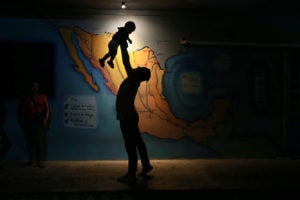
Rise, John Moore
Moore has worked in some 70 countries on six continents and was posted internationally for 17 years. He lived in Pakistan immediately prior to his return to the United States in 2008, when he began a decade-long project on immigration and border security issues.
His subjects ranged from Customs and Border Patrol agents to newly deported immigrants, from Central American gang members to victims of gang violence. One such photograph, entitled Girl Crying on the Border, depicts a young Yanela sobbing at the feet of her mother Sandra who is being searched before being taken into custody.
The powerful image went on to gain international recognition and sparked controversy globally as the U.S. government’s family separation policy emerged. It ultimately won Moore the World Press Photo of the Year in 2019.
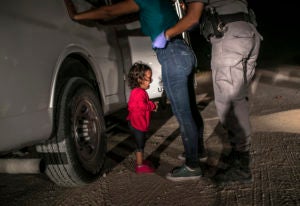
Girl Crying on the Border, John Moore, 2019
Though Moore was thrilled to receive the award, his main goal when taking pictures is always to be respectful of the people he is photographing and to communicate their experiences and his goals truthfully so that others may learn from his photographs.
“When I photograph someone, I try to be as honest as I can, both with the situation I’m documenting and towards the subjects,” Moore says. “What’s happening in the situations I photograph is important. So, when I first ask someone for a photograph, my proposal is always the same whether I am talking to a CBP agent or an immigrant. I’ve noticed that when you are honest and genuine with individuals and their stories, they tend to want to participate.”
The connections Moore creates with his subjects has led to one powerful photograph after another. As the United States becomes increasingly polarized on issues like immigration, the impact of a photograph can be profound. Gordon Ahl (SFS’20) said that he learned a great deal from the images that were shown as well as Moore’s context behind them.

Comfort, John Moore
“John Moore’s presentation helped humanize the impact of U.S. migration policies by explaining the context behind some of his most famous photos,” says Ahl. “This personal style was refreshing since migration is often presented overwhelmingly through numbers and statistics instead.”
Professor Katharine Donato, director for the Institute for the Study of International Migration, says that the work being done by Moore can help shed light on the realities of immigration.
“At a time when deportations have dramatically increased, resources allocated toward border enforcement have grown, and growing numbers of families and children are forced to leave their homes in search of protection, John has been documenting their courageous and powerful stories,” says Donato. “Having him present his work gives voice to these stories at Georgetown and offers us an opportunity to deeply understand the human stories of migrants at the Mexico – U.S. border.”
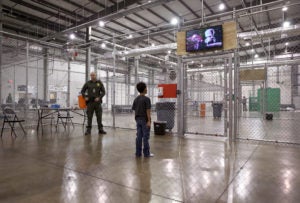
Boy in Cage, John Moore
Wildfires and Climate Change
Keeping in line with his previous work in social reportage, Moore was recently tasked with photographing the aftermath of the Australian wildfires. Although he is not a nature photographer, Moore was eager to shine light on the nonhuman victims of the fire devastation: the animals.
His second talk showed pictures of a huge variety of fauna including kangaroos, wallabies, koalas, wombats, endangered frogs, birds, and fruit bats that were being cared for by various centers across the country. While these creatures suffered severe injuries, the largest threat now facing them is starvation.
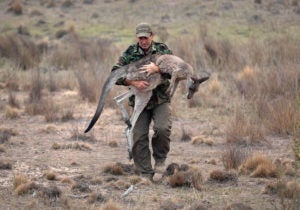
Wildlife Rescue, John Moore, 2020. Animal rescuer Marcus Fillinger carries a bushfire-burned kangaroo in Peak View, Australia.
It is estimated that more than 20% of Australia’s forest, the primary food source for the country’s wildlife, was burned. This enormous track of land could not only negatively impact the animals, but the humans that reside on this continent as well.
It is this common thread of the human experience between immigration and the environment that Moore said drew him to photograph Australia.
Though they may seem like different causes, in reality, they are closely linked. The Australian wildfires were the result of a four-year drought in the country that began due to climate change. Shifts in the environment eventually lead to the migration of people.
“The global economy, immigration and climate change are all intertwined,” says Moore. “When subsistence farmers in Guatemala, for instance, can’t grow their crop for even one season, they have no wiggle room financially, and so they are forced to relocate to a new environment with better working conditions.”
Moore can see himself photographing more climate change and conservation stories in the future as weather patterns continue to become more extreme and negatively affect and greater number of individuals.
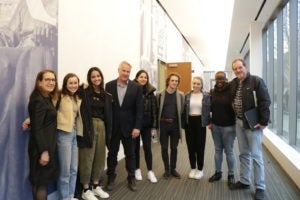
Moore with Georgetown students
A Picture’s Worth a Thousand Words
Moore first became a photographer because of the real-life connections the field provided. Unlike other professions, he does not have the flexibility of not going where his subjects are, which gives him a unique insight into the lives and experiences of others. He also spoke of the importance of photojournalism in terms of informing the public and influencing policy decisions.
“I think, in some ways, photography is more important now than ever, because of the incredible reach of social media,” says Moore. “For me, it’s important to make my photos stylistically artistic, so as to draw in people to the stories I am trying to tell.”
Though the subjects of Moore’s photographs may change, the idea is always the same – share the stories we often hear about, but may rarely witness so that we do not forget what connects us all: our humanity.
More About Moore
Moore joined Getty Images in 2005 after over a dozen years with Associated Press. Now a senior staff photographer and special correspondent, he travels the world taking impactful photographs. In 2018 powerHouse Books published Undocumented: Immigration and the Militarization of the United States-Mexico Border which showed 10 years of photographs by Moore depicting immigration and border security.
He has won top awards throughout his career, including the 2005 Pulitzer Prize for Breaking News Photography, five World Press Photo honors, the Robert Capa Gold Medal from the Overseas Press Club, Photographer of the Year from Pictures of the Year International, the NPPA and Sony World Photography Organization. In 2018, Moore was given the inaugural Impact Award by the Lucie Foundation.
A graduate of the University of Texas at Austin, where he studied Radio-Television-Film, Moore now lives with his family in Stamford, Connecticut.
If you would like to see other work by Moore, follow him on Instagram and Twitter at @jbmoorephoto.
